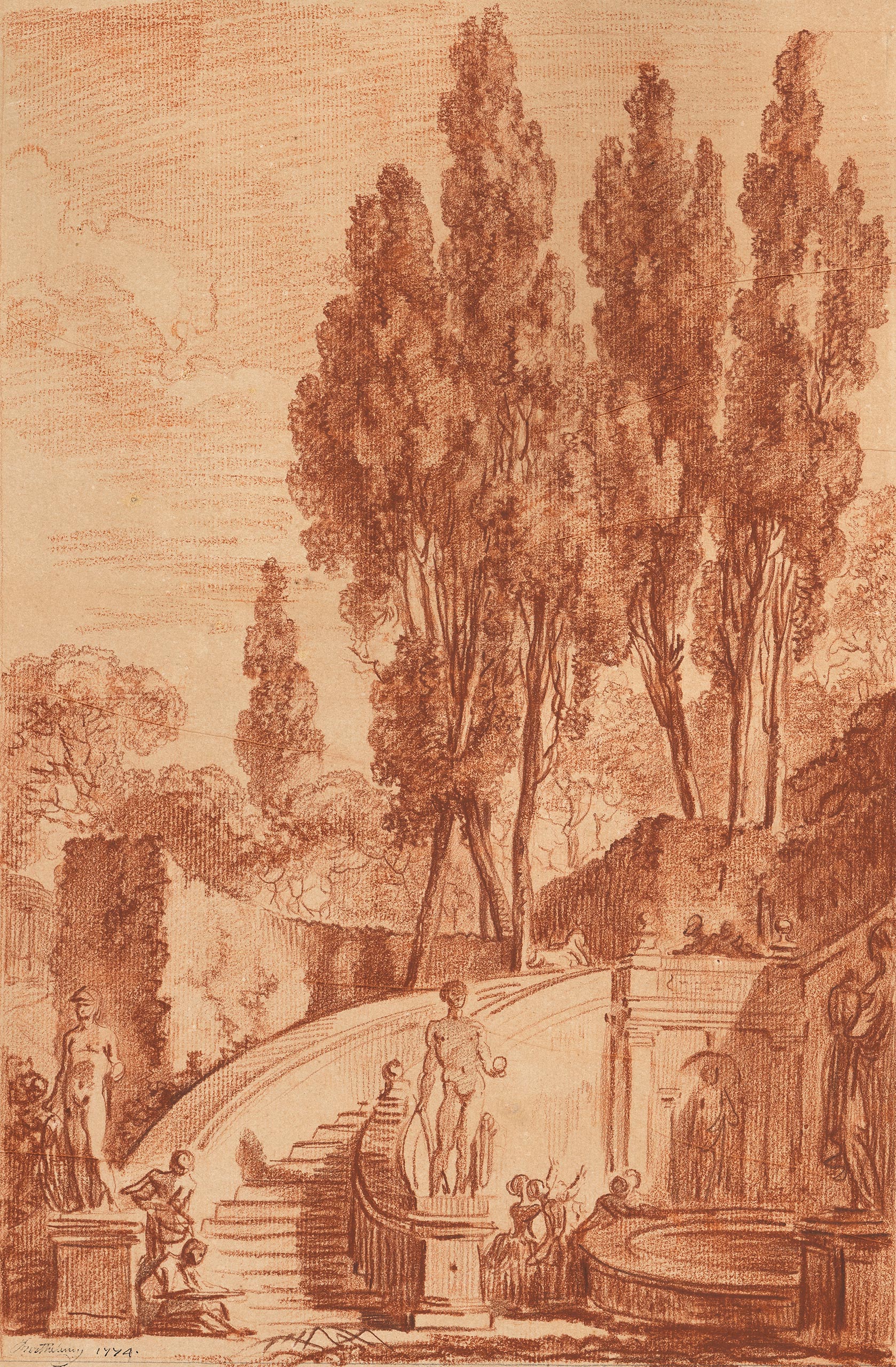
Berthélémy
Jean-Simon
Laon 1743 — Paris 1811
View of the Scala della Girandola at the Villa d’Este
Sanguine. Fine framing lines in pen and black ink.
Signed and dated in pen and brown ink Berthelemy 1774 lower left.
436 x 285 mm (17 3⁄16 x 11 4⁄16 in.)
The son of a carpenter and sculptor from Laon, Berthélémy was sent to Paris to live with his uncle Jean Philippe Berthélémy, also a sculptor, who placed him as a student of Noël Hallé. Berthélémy won the Grand Prix at the Académie royale de peinture et de Sculpture In 1767 and spent two years at the École royale des élèves protégés. He already received a number of important commissions during this period including the decoration of the staircase ceiling in the Hôtel du Comte Saint-Florentin in Paris, and the ballroom ceiling in the Hôtel du Petit-Luxembourg for the Comte de Mercy-Argenteau, both buildings designed by the architect Chalgrin. In Rome, where he arrived on October 8th 1770 for the obligatory four-year stay, he was fascinated by the beauty of Italian nature and drew many landscapes. Our drawing is dated 1774, the final year of Berthélémy’s sejour in Rome, and reflects his fascination with architecture combined with lush Mediterranean landscapes; pines, cypresses, laurel and yew dominate the architecture while scrub and bushes creep behind the stone staircases.
Back in Paris, Berthélémy went from artistic to administrative success. Agrée to the Académie in 1777 and received in 1781, he continued a successful career as a decorative painter, working for the Comte de Vaudreuil to make two cabinets for the Queen at Fontainebleau, and later for the Empire at the Palais du Luxembourg. He painted themes from ancient history as well as nationalistic subjects (a vein that was greatly encouraged by the comte d’Angiviller’s politics in the 1780s) with La Reprise de Paris sur les Anglais (The Retaking of Paris from the English, Versailles, Musée national du Château), for example, while continuing to paint religious works even during the Revolution1. He was appointed costume designer at the Académie royale de musique in 1791, commissioner for the research of scientific objects in Italy in 1796 and curator at the musée central des arts from 1798. The opening of the musée des antiques was one of his main occupations. His beautiful portraits, particularly of Diderot, are also of note.
Nathalie Volle has assembled a body of graphic works that allow a characterisation of Berthélémy as a landscape painter placed somewhere between Hubert Robert and Fragonard. In other words, “halfway between the poetic immateriality of the former and the graphic precision of the latter”2. As the author points out, Berthélémy liked to choose strange viewpoints with elusive angles and blocked perspectives. This sheet, like Funeral Rite at the Foot of a Staircase Leading to a Pyramid also presented on our website, bears witness to this: the staircase begins almost on the lower edge of the sheet with no foreground space and rises towards a perspective-free view, blocked by hedges and tall trees in the background.
The gardens of the Villa d’Este were much appreciated by many artists including Fragonard3. During a trip with Fragonard in 1774, Bergeret de Grandcourt made a point of visiting the Villa d’Este gardens: “The high and low terraced gardens with cypresses and pines of the greatest height still bring acclaim to this villa, being praised and admired by painters who find there a choice of very varied and piquant views. For a long time, painters have never left Rome without making a number of drawings in the Villa d’Este gardens.4” The sheaf staircase in particular offered artists interesting views, both complex and picturesque, from which to draw or paint. In our drawing, Berthélémy looks at the flight of stairs that curves around the left-hand side of the central fountain (not shown in the drawing), but seems to have invented the female statue in the bottom right-hand corner in order to close off the composition, in effect reinterpreting the space around the sheaf staircase to construct an autonomous composition. Berthélémy treats the same point of view in a larger drawing, with differences in the figures, that belongs to the Kunstbibliothek in Berlin5 (Fig. 1). Two women and the child at the foot of the stairs on the Berlin sheet are replaced by a draughtsman and his companion in our drawing. Similarly, the bush on the left of the fountain has been replaced by a group of female figures greeting the figures on the intermediate level of the staircase. Most of all, our sheet is more sketchy and rapid, particularly noticeable in the treatment of the architecture and the trees. The Berlin sheet could be a counter-proof, suggested by the cross-hatching made from left to right; another drawing of this view or the other staircase, with mark making executed in the opposite sense, would have served to make the counter-proof6.
- This is evidenced by The Assumption produced for the Bernardines du Savoir-sous-Laon in 1790 and The Holy Family in Egypt made for the Saint-Esprit seminary in Paris.
- Nathalie Volle, Jean-Simon Berthélemy, peintre d’histoire (1743- 1811), Paris, Athena, 1979, p. 27.
- Fragonard made spectacular views with complex perspectives. For example, Besançon D2844.
- Bergeret et Fragonard: journal inédit d’un voyage en Italie 1773-1774, Paris, published by May and Motteroz, 1895, p. 281.
- N. Volle, op. cit., n° 126, repr. Fig. 93, dim. 59 x 34 cm.
- See Catherine Boulot, Jean-Pierre Cuzin, Pierre Rosenberg, Honoré Fragonard et Hubert Robert a Roma, Rome, Palombi, 1990, p. 255, n° 182.

